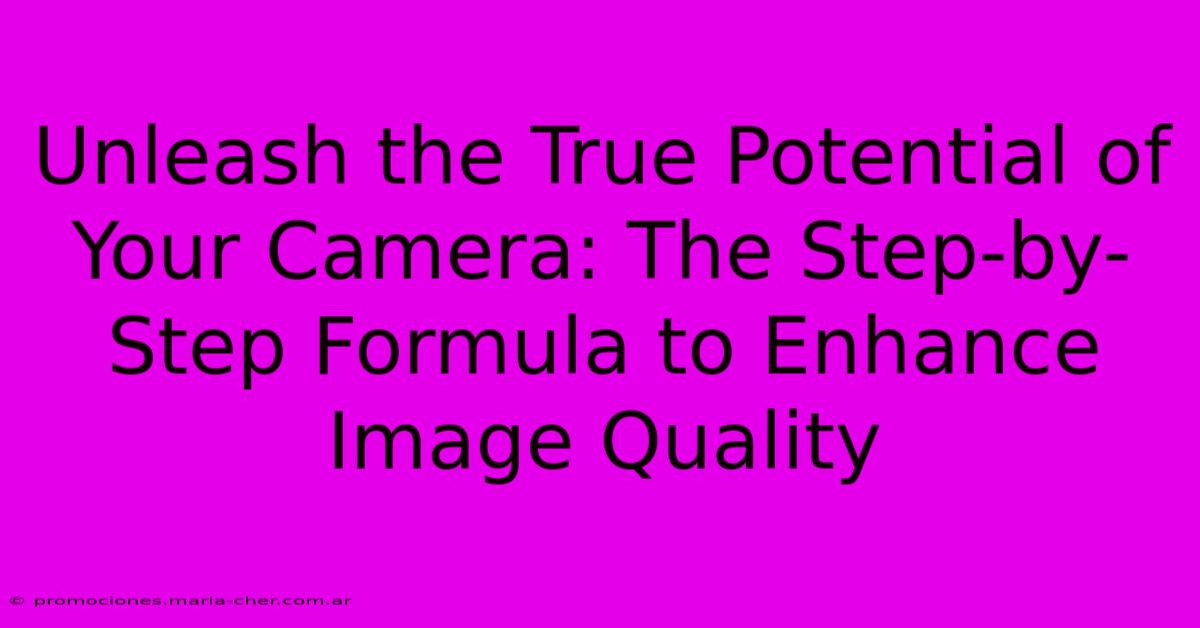Unleash The True Potential Of Your Camera: The Step-by-Step Formula To Enhance Image Quality

Table of Contents
Unleash the True Potential of Your Camera: The Step-by-Step Formula to Enhance Image Quality
Are you tired of your photos looking…okay? Do you yearn to capture images that truly reflect the beauty you see with your own eyes? You’re not alone! Many photographers, regardless of their skill level, struggle to unlock their camera's full potential. This comprehensive guide provides a step-by-step formula to significantly enhance your image quality, transforming your photography from average to amazing.
Understanding the Fundamentals: Mastering Exposure
Before diving into advanced techniques, mastering the exposure triangle is paramount. This fundamental trio – aperture, shutter speed, and ISO – dictates the brightness and overall look of your images.
Aperture (f-stop):
- What it is: The size of the opening in your lens diaphragm. A wider aperture (smaller f-number, e.g., f/2.8) lets in more light, creating a shallow depth of field (blurred background). A narrower aperture (larger f-number, e.g., f/16) lets in less light, resulting in a greater depth of field (everything in focus).
- Impact on Image Quality: A wider aperture can create stunning bokeh (background blur), but can also lead to less sharp images if not carefully focused. A narrower aperture ensures more of the scene is in focus but might require longer shutter speeds.
Shutter Speed:
- What it is: The length of time your camera's shutter stays open, exposing the sensor to light. A faster shutter speed (e.g., 1/500th of a second) freezes motion, while a slower shutter speed (e.g., 1/2 second) can blur motion, creating interesting effects.
- Impact on Image Quality: Faster shutter speeds prevent motion blur, crucial for capturing sharp images of moving subjects. However, they require more light. Slower shutter speeds can introduce motion blur, which can be artistic but requires a stable camera (tripod recommended).
ISO:
- What it is: The sensitivity of your camera's sensor to light. A lower ISO (e.g., ISO 100) is less sensitive, resulting in cleaner images with less noise (grain). A higher ISO (e.g., ISO 3200) is more sensitive, allowing for shooting in low light, but introduces more noise.
- Impact on Image Quality: Keeping ISO as low as possible is generally ideal for the best image quality. However, in low-light situations, increasing ISO is necessary, accepting a trade-off between image noise and usable exposure.
Beyond Exposure: Fine-tuning Your Camera Settings
Mastering exposure is a crucial first step, but several other settings significantly impact image quality:
White Balance:
Accurate white balance ensures colors appear natural and avoids unwanted color casts. Experiment with different white balance presets (e.g., Daylight, Shade, Cloudy) or use custom white balance for precise control.
Focus Mode:
Choose the appropriate focus mode (e.g., Single-servo AF, Continuous AF) depending on your subject's movement. Mastering autofocus techniques will significantly improve image sharpness.
Image Format:
Shooting in RAW format provides more flexibility in post-processing, allowing for greater control over color, exposure, and other aspects. While JPEGs are convenient, RAW files offer superior image quality.
Post-Processing: The Secret Weapon
Even the best in-camera settings benefit from post-processing. Software like Adobe Lightroom or Photoshop allows for:
- Color Correction and Enhancement: Adjust vibrance, saturation, and white balance to refine colors.
- Exposure Adjustments: Fine-tune highlights, shadows, and mid-tones for optimal exposure.
- Sharpness and Noise Reduction: Enhance image sharpness while minimizing noise for cleaner results.
- Cropping and Composition: Improve composition by cropping and straightening the image.
Practice Makes Perfect: Consistent Improvement
The key to unlocking your camera's true potential is consistent practice. Experiment with different settings, lighting conditions, and subjects. Analyze your images, identify areas for improvement, and continually refine your techniques. Don't be afraid to make mistakes – they're valuable learning opportunities. The more you shoot, the better you'll become.
Conclusion: Embrace the Journey
Enhancing image quality is an ongoing journey, not a destination. By understanding the fundamentals of exposure, fine-tuning your camera settings, and mastering post-processing techniques, you can unlock the true potential of your camera and capture stunning images that truly reflect your vision. So grab your camera, experiment, and start creating breathtaking photographs today!

Thank you for visiting our website wich cover about Unleash The True Potential Of Your Camera: The Step-by-Step Formula To Enhance Image Quality. We hope the information provided has been useful to you. Feel free to contact us if you have any questions or need further assistance. See you next time and dont miss to bookmark.
Featured Posts
-
Eyewitness Accounts The Harrowing Truth Behind The Buhl Shooting
Feb 08, 2025
-
Frozen In Time The Timeless Appeal Of A Cool Summer Palette
Feb 08, 2025
-
White Roses Unraveling The Mystery Of Their Floral Language
Feb 08, 2025
-
Meme O Matic Create Hilarious Memes From Any Image Instantly
Feb 08, 2025
-
Polaroid Picture Sizes 101 The Essential Guide For Photography Enthusiasts
Feb 08, 2025
